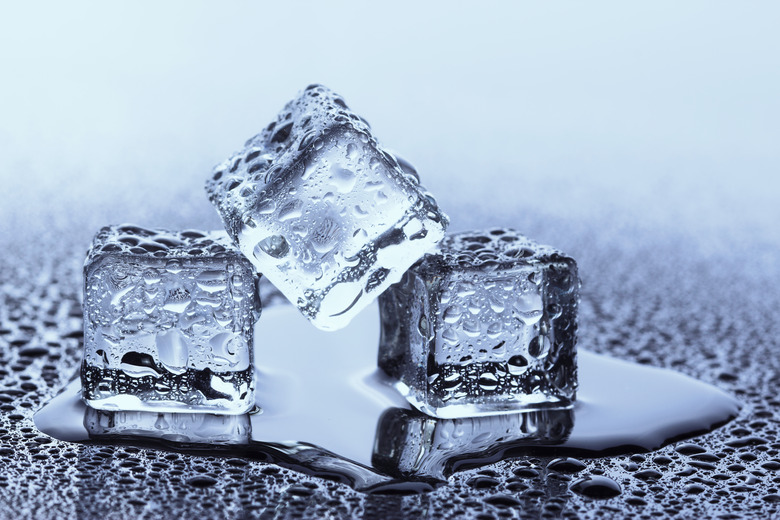Ice Cubes Melting Process
Everything in the world is made up of particles that act differently depending on the state they are in. An ice cube is made of water particles, but it is a solid because its particles are packed closely together, resulting in its hard, fixed state.
TL;DR (Too Long; Didn't Read)
When a solid ice cube is removed from a freezer, the warmer air gives its particles the heat energy they need to spread apart.
Solid to Liquid Particles
Solid to Liquid Particles
When you take ice cubes out of the freezer, the melting process begins right away because the air temperature around the ice cubes is warmer than the temperature in the freezer. Water freezes at zero degrees Celsius (32 degrees Fahrenheit). The solid ice particles absorb heat energy from the warmer air, giving the particles energy and enabling them to move away from one another. Liquid particles still touch each other, but they are further apart than solid particles. They slide past each other and don't have a regular shape like solids do. This is what happens when the ice cube (a solid) turns into water (a liquid). The reason an ice cube takes up a much smaller area than it does when it melts is that the once-compact particles have spread out and take up more space.
Liquid to Gas Particles
Liquid to Gas Particles
You might think an ice cube has completely melted when it turns into liquid, but the process can go much further. If the temperature surrounding the liquid reaches its boiling point of 100 degrees Celsius (12 degrees F), the water evaporates and turns into water vapor. The heat gives the liquid particles enough energy to break away from one another until they are sparsely spaced they can't be seen by the naked eye. They are now randomly arranged and can move freely in all directions.
Accelerating the Melting Process
Accelerating the Melting Process
If you want to melt ice cubes faster, you have to lower the ice's freezing point – make it melt into a liquid at a lower temperature than normal. The easiest way to do this is to sprinkle salt (sodium chloride) on the ice cubes. Pure ice cubes contain only ice and water, which are said to be in dynamic equilibrium with each other. The balance between freezing and melting can be maintained at the freezing-melting point of 0 degrees Celsius (32 degrees F) unless conditions change in a way that favors one of the processes over the other. Adding salt changes the conditions because the salt molecules dissolve in the water but do not pack easily into the cluster of molecules in the solid. There are fewer water molecules on the liquid side because some of the water has been substituted with salt, so the rate of freezing drops.
Cite This Article
MLA
Gillespie, Claire. "Ice Cubes Melting Process" sciencing.com, https://www.sciencing.com/ice-cubes-melting-process-5415212/. 26 April 2018.
APA
Gillespie, Claire. (2018, April 26). Ice Cubes Melting Process. sciencing.com. Retrieved from https://www.sciencing.com/ice-cubes-melting-process-5415212/
Chicago
Gillespie, Claire. Ice Cubes Melting Process last modified March 24, 2022. https://www.sciencing.com/ice-cubes-melting-process-5415212/
